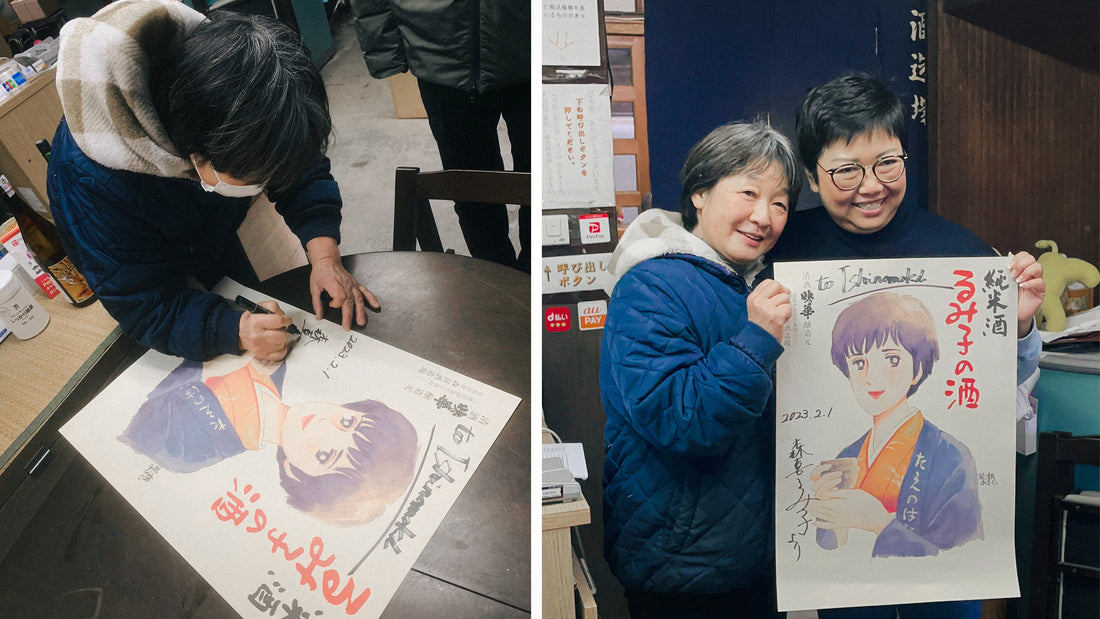
Seeking Authenticity and Upholding Tradition

手造りの酒倉 (which translates to a sake brewery rooted in handcrafted sake) - these were the words that warmly welcomed us, setting the tone for our visit to Moriki Brewery in Iga, Mie Prefecture last year. By then, we were already big fans of Rumiko Moriki, the fifth generation owner of the brewery and one of Japan’s first women tojis (master brewers). You can imagine our excitement to get a behind-the-scenes look at the operation, meet the team, and of course, Rumiko herself.
Rumiko Moriki, along with her creations, showed us that sake goes beyond mere refinement and elegance. It possesses the potential to be complex, full of character, and even pack a masculine punch – all the more significant coming from a female master brewer.
 Above Rumiko Moriki and her her biochemist husband, Hideki Moriki
Above Rumiko Moriki and her her biochemist husband, Hideki Moriki
As we stepped into the brewery, it became clear that this was more than a modest, family-owned establishment; it was a resourceful powerhouse that had propelled the brand to where it stands today. As the face of the company, Rumiko-san’s energetic and bubbly personality was immediately infectious from the moment we first encountered her.
How it all started
Moriki Brewery (Rumiko Moriki took over since 1988) → Rumiko no Sake (since 1991)
 Left Manga series Natsuko no sake (Natsuko’s Sake) by Akira Oze Right An article clipping of the brand Rumiko no sake (Rumiko's Sake) dated 1992 (Heisei 4)
Left Manga series Natsuko no sake (Natsuko’s Sake) by Akira Oze Right An article clipping of the brand Rumiko no sake (Rumiko's Sake) dated 1992 (Heisei 4)
The brand, Rumiko no sake (Rumiko’s Sake) did not happen in a vacuum. It all traces back to the manga series Natsuko no sake (Natsuko’s Sake) by Akira Oze, a crucial influence that shaped the brand’s creation and transformed it into something more.
The story follows Natsuko, a young woman working as a copywriter in Tokyo who, after her brother's unexpected death, takes over her family's brewery in Niigata. Her mission: to revive a long-lost heirloom rice and brew the ultimate junmaishu, continuing her brother's legacy.
In Natsuko’s journey, Rumiko saw a reflection of her own experiences. The manga's portrayal of the challenges faced by the sake-brewing industry in the late '80s and early '90s deeply resonated with Rumiko. While many around her were resorting to producing futsushu (regular sake) to cut costs, sacrificing quality in the process, she and her husband were drawn to the revived junmai sakes. The manga's exploration of traditional sake-making methods and Natsuko’s pursuit of truly great sake mirrored Rumiko's own aspirations.
When Rumiko’s father suffered a stroke in the mid-'90s and could no longer run the brewery, she left her job at a pharmaceutical company and joined her husband in working alongside the company's seasonal Toji. At the age of 28, despite the challenges faced by the brewery during her parents' generation, her father's intention to close it down and the fact that women were almost totally banned from brewing sites at that time, Rumiko felt compelled to take over, fuelled by her deep passion for sake and the strength and inspiration drawn from the manga.

Right after Rumiko finished reading the manga at 1am on June 22, 1991, she penned a letter to the author, expressing her connection to the story. She shared, “Just like Natsuko, I grew up right next to fermenting tanks, learning the taste of sake before knowing much about the world. Back in elementary school, I already knew how delicious the arabashiri dripping from the tank was. After school, I would secretly take some from the tank. I may not be an expert taster, but I think I understand delicious sake.” Interestingly, Natsuko and Rumiko share the same birthday, February 7.
The letter caught Oze's attention, and he shared it with his friends in Saitama who were sake brewers and owners of sake shops. They were deeply touched by the story to the point that they visited Rumiko in Mie to assist with brewing and offer advice. Oze also invited Rumiko to a sake study group meeting in Tokyo, where she connected with notable Junmai brewers, including Yoshimasa Ogawahara of Shinkame Sake Brewery (all-junmai brewery), who later became an important mentor to her. She made the trip with her one and a half year old son on her back, all while being pregnant with her third child.
As you may have guessed, the distinctive label illustration featuring Rumiko herself was designed by Oze in the style of his manga.
With Moriki Brewery on solid ground, Rumiko took it a step further and decided to lend a hand to other women wanting to work in sake brewing. By 1999, Rumiko launched the first Kurajosei Summit (Women in Sake-Brewing Summit), providing a platform for women to support each other and exchange information through biannual conferences, workspace tours and offering emotional support. As Rumiko puts it, “It helps when you can talk to people with the same struggles."
Present
The brand has since established itself as a maker of organic, minimally manipulated sakes, predominantly junmai, and traditional Kimotos and Yamahais.
 Above Moriki Shuzo's 5000 sqm pesticide-free rice paddies. They can only work on the planting of rice in the early morning around 5 o’clock during the hot summer months at the end May/early June
Above Moriki Shuzo's 5000 sqm pesticide-free rice paddies. They can only work on the planting of rice in the early morning around 5 o’clock during the hot summer months at the end May/early June
 Above Isenishiki (polished to 60%), a native rice variety of Mie Prefecture since the end of Edo period (~1860)
Above Isenishiki (polished to 60%), a native rice variety of Mie Prefecture since the end of Edo period (~1860)
Nearly all the work is done laboriously by hand, involving a small team of seven, including the cultivation of their own organic rice. It is impressive how they embrace the painstaking process to maintain the integrity of their craft - something which, if you’ve had the pleasure of tasting any of their labels, you will know, shines through in each bottle.

 Above Making of koji in the muro (koji-making room), where temperature and humidity are closely monitored
Above Making of koji in the muro (koji-making room), where temperature and humidity are closely monitored
Below The fermenting mash at various stages and kimoto and yamahai sake brewed with classic yeasts (Kyokai No. 9 & 10)
 Above The brewery's 40 ft container, which also serves as a reizoko (chiller). Depending on the sake, temperature will be adjusted (e.g. -5°C for Namazake, 5°C for Junmai Ginjo/Ginjo, 15°C for Junmai)
Above The brewery's 40 ft container, which also serves as a reizoko (chiller). Depending on the sake, temperature will be adjusted (e.g. -5°C for Namazake, 5°C for Junmai Ginjo/Ginjo, 15°C for Junmai)

Left Rie Toyomoto, a graduate of Tokyo University of Agriculture (Nodai) who has worked alongside Rumiko and Hideki for 20 years, took over as toji in 2016, succeeding Rumiko.

There are a couple of things that both Rumiko and we enjoy. First, we believe in the power of aging sake, particularly the junmai labels with high acidity. We also enjoy trying sake at different temperatures, especially warming it up (e.g. Hitohadakan at 35°C, Nurukan at 40°C and Atsukan at 50°C).
Rumiko’s sake can be described as bold and appealingly complex, yet refined. What’s even more important is its versatility in food pairing. This is very much like Rumiko herself: strong yet gentle, authentic and dedicated, simply doing things she believes (and being really good at it).

Rumiko became a true trailblazer, driven not only by economic necessity but also by her belief in women’s empowerment in the male-dominated sake world. Spending time with Rumiko and savouring her sake, we felt that Rumiko had stayed true to her ideals, both by what she took and what she so generously gave of herself to it: her heart, humour and inimitable spirit.
